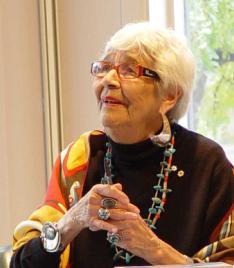Daphne Odjig facts for kids
Quick facts for kids
Daphne Odjig
|
|
|---|---|

Odjig in October 2008 at Gallery Gevik in Toronto
|
|
| Born | September 11, 1919 Wiikwemkoong, Ontario, Canada
|
| Died | October 1, 2016 (aged 97) Kelowna, British Columbia, Canada
|
| Awards | Order of Canada, 1986 Governor General's Award in Visual and Media Arts, 2007 |
| Elected | Royal Canadian Academy of Arts, 1989 |
Daphne Odjig (September 11, 1919 – October 1, 2016) was a famous First Nations artist from Canada. She had Odawa, Potawatomi, and English family roots. Her paintings are known for a special style called Woodlands Style. This style often uses strong outlines and bright colors.
Daphne Odjig was a key leader in creating the Professional Native Indian Artists Association. People often called this group the Indian Group of Seven. This group helped bring First Nations art into the spotlight in Canada. She won many important awards for her art, like the Order of Canada.
Contents
Early Life and Artistic Beginnings
Daphne Odjig was born in 1919 in Wiikwemkoong, a village on Manitoulin Island in Ontario. Her parents were Dominic and Joyce Odjig. She was the oldest of four children. Her father's family came from the Potawatomi people. Her mother was English.
When Daphne was 13, she became very sick with rheumatic fever. She had to leave school to get better at home. During this time, she spent a lot of time with her grandfather, Jonas Odjig. He was a stone carver and taught her about art. Her parents also encouraged her to draw and create. Daphne often said her grandfather was her first art teacher.
When she was 18, both her mother and grandfather passed away. Daphne then moved to Parry Sound, Ontario. Later, when World War II started, she moved to Toronto to find work. She worked in factories but spent her free time visiting art galleries. She was especially interested in Cubist art by artists like Picasso.
A Career in Art
After World War II ended in 1945, Daphne Odjig moved to British Columbia. In the 1960s, she moved again to Manitoba. Her art career really took off in the early 1960s. She became well-known for her drawings of Cree people from northern Manitoba. She wanted to capture their traditional ways of life in her art. She hoped this would help preserve their culture. In 1963, she was officially recognized as an artist. She joined the British Columbia Federation of Artists.
In 1971, Daphne opened her own shop in Winnipeg. It was called Odjig Indian Prints of Canada. In 1973, she helped start the Professional Native Indian Artists Association. Other artists like Alex Janvier and Norval Morrisseau were also part of this group. The group held art shows together. Even though the group didn't last long, its members were very important. They helped develop Indigenous art in Canada. Daphne said that they supported each other when the art world didn't always accept them.
This group helped bring First Nations art to a wider audience. In 1974, Daphne and her husband expanded their shop. They renamed it the New Warehouse Gallery. This was the first gallery in Canada that showed only First Nations art. It was also the first art gallery owned and run by a Native person in Canada.
Art Style and Important Themes
Daphne Odjig's early paintings looked very realistic. But later, she started trying out other styles. These included expressionism and cubism. She created her own unique style. It mixed traditional Indigenous pictographs and First Nations art with European art techniques. The National Gallery of Canada describes her art as having "curving contours, strong outlining, overlapping shapes and an unsurpassed sense of color." She said the rounded shapes in her art came from her grandfather's carved tombstones.
In the 1960s, Daphne began painting stories from Manitoulin legends. In the 1970s, she focused more on her Indigenous heritage and culture. She also explored how colonialism affected her people. Her art often showed myths, history, and landscapes. She also painted about human feelings, relationships, and the importance of family. Her later works used intense colors and became more personal.
Awards and Recognition
Daphne Odjig's art is in many public collections. These include the Canadian Museum of History and the McMichael Canadian Art Collection. She was asked to create art for Expo '70 in Japan. She also made art for the Manitoba Museum and El Al, an Israeli airline.
Many books and documentaries have been made about Daphne Odjig. She received many honors for her work. These include honorary doctorates from several universities. She received the Order of Canada in 1986. This is one of Canada's highest honors. In 2007, she won the Governor General's Award in Visual and Media Arts. Canada Post even put three of her paintings on Canadian postage stamps in 2011. She also received the Eagle Feather for her artistic achievements.
Art Exhibitions
Daphne Odjig traveled a lot and showed her art in many countries. She had over 30 solo art shows. She also took part in more than 50 group exhibitions.
A special show called The Drawings and Paintings of Daphne Odjig: A Retrospective Exhibition showed her work from over 40 years. This exhibit traveled to several galleries, including the National Gallery of Canada. Even though she had arthritis in her right hand, she kept sketching in her later years.
Personal Life
Daphne Odjig met Paul Somerville in Toronto. They got married and moved to British Columbia. They had two sons, David and Stanly. Paul Somerville later died in a car accident. In 1962, Daphne married Chester Beavon. He worked to help Indigenous communities. The family then moved to Manitoba.
Daphne Odjig passed away on October 1, 2016, in Kelowna, British Columbia, Canada.

